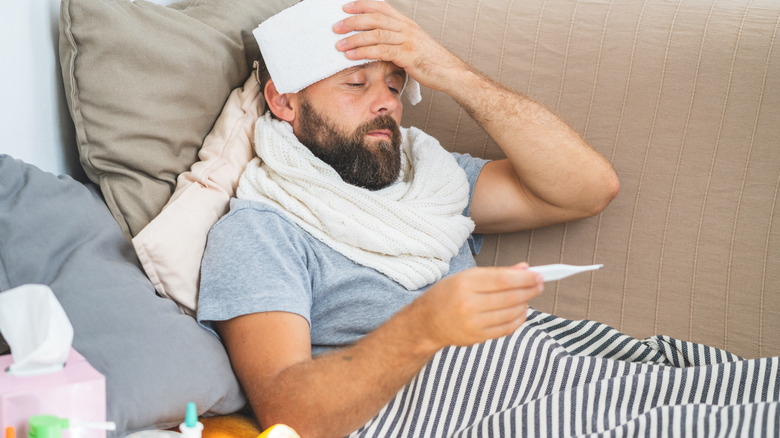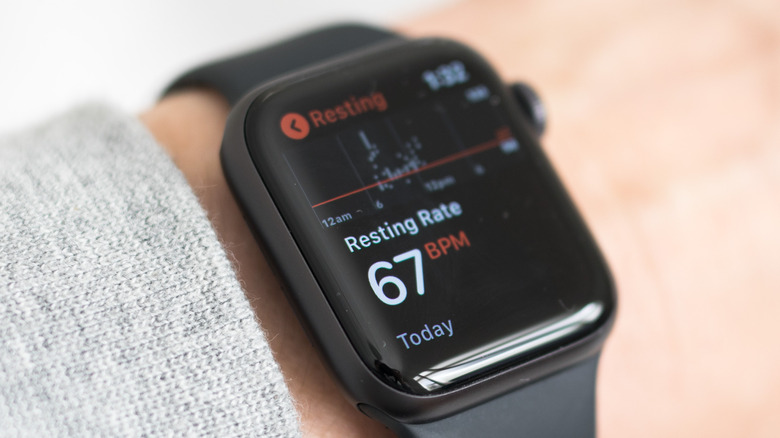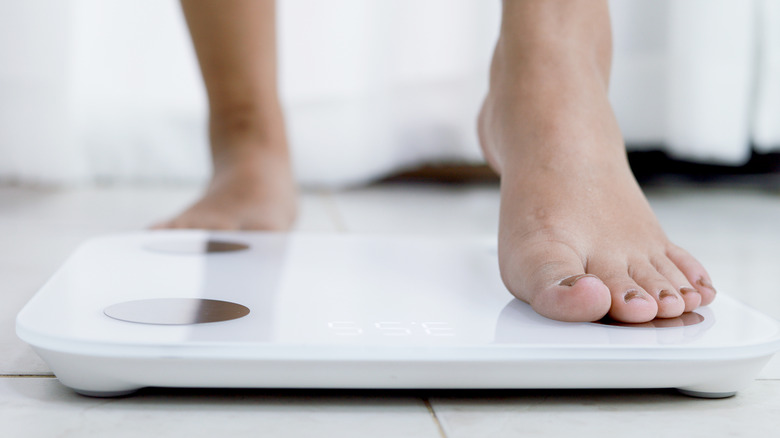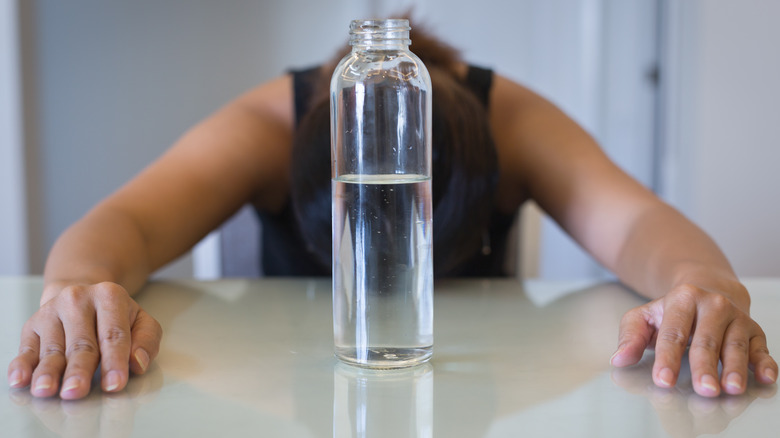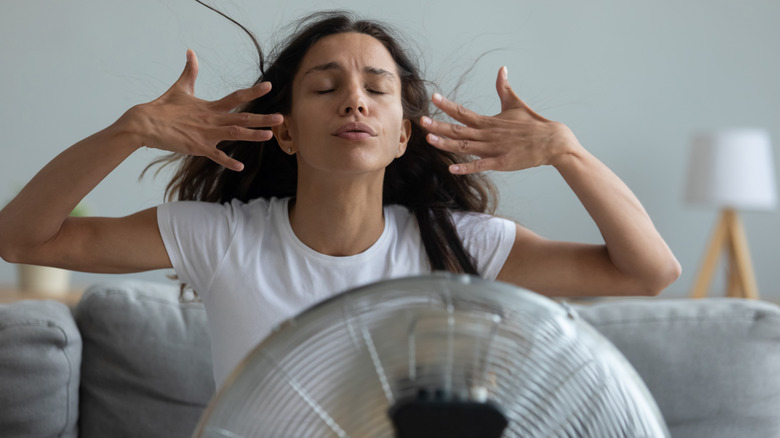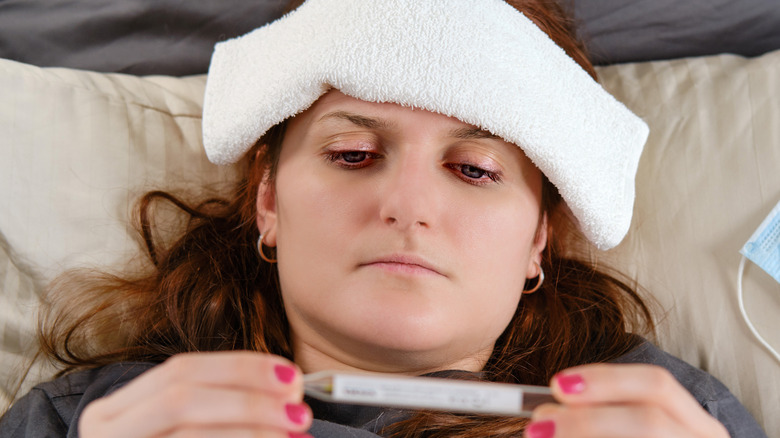When You Get A Fever, This Is What Happens To Your Body
Think of your body as an ideal habitat for everything inside, just like how you feel on a sunny, comfortably warm day. Your cells, organs, and blood happily coexist in this perfect environment most of the time. However, when harmful germs approach, your body kicks into action to boot the unwanted visitors.
When this happens, you may end up with a fever. While some people panic when they notice their thermometer reading over 100 degrees Fahrenheit, a fever is actually a good thing. Essentially, it's the body's way of getting everything back to its comfortable state once it fights off the intruding infection or illness.
While the average human body temperature is 98.6 degrees, having a higher temperature doesn't always mean you have a fever. According to WebMD, it's normal for yours to fluctuate as much as 2 degrees from that number. Once you reach 100 degrees, you might have a fever that's trying to ward off infection. If you've ever wondered what happens to your body when your forehead starts to feel hot, this information is for you.
Preparing for defense
Your body has numerous processes working around the clock. Most of the time, you have no idea when they're happening, but you rely on your body to do its job. Your immune system works this way, always staying on its toes to make sure that it can properly defend against anything that isn't supposed to be there.
The primary part of the immune system is the white blood cells. These cells hold information from previous infections to be able to quickly recognize and attack them if they were to enter the body again. Together with antibodies, white blood cells defend the body against illness and infection (via the State Government of Victoria's Department of Health).
However, they sometimes need the help of a fever to do their job effectively. A fever happens when the body makes more white blood cells to attack foreign substances, heating up the body to prepare for all the extra work it has to do to defend against infection (per Cancer Research UK).
Fevers arm the body with immunity
Although a fever can sometimes leave you feeling as miserable as your illness does, it has good intentions. In fact, your fever helps your immune system do its job. Once your white blood cells detect infection, they work in overdrive to try to rid the body of all the "bad stuff." According to WebMD, the higher body temperature created by a fever helps your immune cells speed up what they're doing to get you back to normal. Plus, "bad" cells can't thrive when they're in an environment that's not ideal for them, like your fevered body.
As your body temperature rises, it can interfere with that cozy, calm environment we mentioned earlier. While that's bad news for you temporarily, it's worse for infectious cells long-term. "Our immune system releases inflammatory chemicals that increase the heat in the body and increase our core temperature," family medicine physician Dr. Donald Ford told the Cleveland Clinic. "Part of what happens is that it makes it very uncomfortable for the virus to live. So we're literally trying to cook the virus out of our bodies."
Your body gets stressed
Although a fever is a sign that your body is reacting appropriately to infection, it may not seem like it based on the way you feel. A fever can make you achy, moody, hot, cold, and just plain uncomfortable. However, you're probably feeling better than your inner body is feeling, as it undergoes a lot of stress when a fever hits.
According to Scientific American, fever puts the body's processes and systems through a lot. One area you might notice feeling off is your digestive system with bouts of nausea or diarrhea. When the body is under stress, as is the case with fever, it signals to the digestive system to trigger the parasympathetic nervous system. This system responds to emergencies, leading to the fight-or-flight response (via Hospital for Special Surgery). However, the whole system can get out of whack when you have a fever because of the stress on your body.
A 2021 academic article published in Evolution, Medicine, and Public Health explains that fever purposely stresses pathogens that enter the body. To cause that stress, however, it has to create stressors, like iron deprivation, to prevent pathogens from thriving. Sometimes, the body doesn't have the means to overcome the stress added to the body, which is when other conditions can occur, like seizures.
Cold and hot, chills and sweats
When you first come down with a fever, your head and face often feel like they're on fire. However, the rest of you might feel cold, possibly even to the point of shivering. Then, you try to nap and wake up in sweaty clothes and blankets. What's going on?
It's all part of the process to fight infection. Your body needs to generate more heat to get rid of pathogens that entered the body. One way to do that is to cause you to shiver, a natural way we keep ourselves warm when we're cold. Your body takes the heat it needs to defend itself against the intruding virus, dropping your body temperature and sending you into a rage of shivers to keep increasing it (per Everyday Health).
Once your body determines it has enough heat to do what it needs to, you might feel less chilled and possibly get hot enough to the point of sweating. Sweating usually occurs when a fever breaks, but you can also experience periods of chills and sweats until the fever has completely run its course (per Healthline).
Inflammation and body aches can accompany fever
You know that achy feeling you get when you have a fever that makes you not want to get out of bed? That's mostly thanks to the shivering you do when you start to feel cold as your body internally heats up. According to MedicalNewsToday, the act of regulating body temperature causes muscle tension if you're unable to keep yourself warm enough to prevent shivering.
While a fever can cause aches and pains, it's actually more common that the condition causing your fever is triggering those pains. This is especially true with conditions that cause inflammation. According to a 2011 scientific review published in the Journal of Infection and Public Health, some types of inflammation cause cold-sensitive nerves to react, eventually signaling to the brain that the fever response should start.
Inflammation can happen when an infection gets inside the body, as it's just another defense mechanism our immune systems use to fight pathogens. Unfortunately, with inflammation often comes pain, as fluid buildup presses on the nerves (per MedicalNewsToday).
Your heart rate gets faster
A resting heart rate of 60-100 beats per minute is normal for most adults, according to the American Heart Association. Your resting heart rate is how frequently your heart beats when you're not physically exerting yourself. Certain factors, like exercise and stress, can affect your resting heart rate.
When you have a fever, your body temperature increases, and that rise can cause your heart to beat faster, even at rest. Cardiologist Dr. Jason Hatch tells Banner Health that, when you have an illness that induces a fever, your heart pumps more blood. "If a person's physical demands for more blood increases, then the heart rate is generally the first to increase to meet that demand," Dr. Hatch told Banner Health.
One thing you'll want to watch for is your resting heart rate going over 100 beats per minute, resulting in a condition known as tachycardia. High, consistent fever can sometimes cause the condition, which may lead to heart attacks, stroke, or death, in rare circumstances. If you notice shortness of breath, chest pain, or heart palpitations along with your high heart rate, you should call the doctor (via the Mayo Clinic).
You have weird bladder symptoms
You might notice some strange things happening with your bladder when you have a fever. One symptom is hot urine, or the feeling that your pee is hotter than usual when you use the bathroom. Under normal circumstances, your urine is the same temperature as your body. Therefore, when you get a fever, your rising body temperature also makes your pee temperature go up. The few-degree increase can feel a lot different from what you're used to, though (per Healthline).
You might also notice that you need to urinate more frequently than usual. While fever and frequent urination can go hand-in-hand, it's not necessarily the fever that causes you to use the bathroom more. Instead, you might have an accompanying condition that's triggering your overactive bladder. MedicineNet lists some of the most common conditions, such as urinary tract infections, sinusitis, sore throat-causing illnesses, and type 2 diabetes. Additionally, a urinary tract infection could cause a fever before you notice any other symptoms, like painful or frequent urination (via Henry Ford Health System).
Calories burn faster
Calories burn because of metabolism. When metabolism increases, you burn more calories. Although you might be resting a lot more when you're ill, your body isn't really doing the same, especially if it's fevered. When a fever occurs, your increased body temperature ramps up your metabolism, which relies on calories to keep powering through its processes. If you're shivering because your fever is making you cold, you'll also end up burning more calories than you would if you were resting as usual (via Livestrong).
So, what about the age-old saying, "Feed a cold, starve a fever?" According to Scientific American, it makes more sense to eat more when you have a fever because you burn so many calories. Your body needs fuel to keep doing its job when it's consuming so much of your energy. Even more important than eating is drinking to prevent dehydration, especially when you have a sinus infection or cold. Staying hydrated keeps your nasal passages moist, making it easier to remove bacteria-filled gunk when you cough and sneeze.
Fevers can play tricks on your brain
UnityPoint Health states that high fevers — typically between 103-106 degrees Fahrenheit — can cause hallucinations and confusion. According to Science Focus, your body's temperature can affect brain function, so a high temperature stemming from fever could result in hallucinations, even when you're sleeping. This is especially true if your fever hasn't gone down before bed, as your body has to work harder to control temperature during rapid eye movement (REM) sleep. Therefore, your dreams could be a lot more realistic-feeling than they usually are.
While being in a confused state with a fever can feel a little scary, again, it's not something to usually worry about. According to Healthline, most fever hallucinations don't last very long, and you might only see brief images or hear a few sounds before feeling "normal" again. And, if you're able to control your fever with fever-reducing medication, you may not experience much or any cognitive side effects.
Your body craves water
Dehydration is a primary concern for people with a fever because you sweat more than usual as your body works to regulate your temperature. Higher fevers usually lead to dehydration more quickly for this reason, and fevers accompanied by vomiting or diarrhea carry even more of a risk of dehydration (per the Mayo Clinic). A 2018 study published in the Journal of the American Medical Directors Association on nursing home residents found that fever was a leading risk factor for dehydration in long-term care residents.
It's a common misconception that "sweating out a fever" is a good thing for your body. This age-old adage refers to keeping your body hot when you have a fever. The theory goes that as you continue to sweat, you allow all the bad gunk to leave. However, this may not be true. "Whether it's a flu or COVID, an infection doesn't leave our body through bodily fluids, and sweating more doesn't make a fever better," family medicine practitioner Dr. Tina Ardon told Prevention.
In fact, it could make your situation worse if you're not replenishing all those fluids you lose. When you're feeling crummy with a high fever, it's also easy to take a nap instead of keeping up with your water intake. According to Dr. Ardon, it's a good idea to make yourself comfortable enough with a fever to be able to stay hydrated, and Tylenol or ibuprofen can usually do the trick.
Fevers sometimes cause seizures
Seizure-causing fevers aren't the norm, but they do happen, especially in young children. These seizures are known as febrile seizures, and they cause convulsions that may last several minutes. Most commonly, these seizures occur with fevers over 101 degrees Fahrenheit in children up to age 5. In most cases, febrile seizures won't lead to long-term health effects, but in rare cases, epilepsy can develop (via the National Institute of Neurological Disorders and Stroke).
According to MedlinePlus, a febrile seizure usually happens within the first 24 hours of illness, even when a fever isn't too high yet. Unfortunately, there's no way to prevent febrile seizures completely. While trying to bring a fever down may help, it won't entirely prevent future seizures. Instead, parents and caregivers should be prepared to help their child through a seizure by monitoring the child throughout the seizure, loosening tight clothing, and making sure the child is on a safe surface, away from any dangerous objects.
The cooling-off period
When a fever has done its job to help your immune system, it will start to break. During this period, your body cools down as the brain signals to it that the fever is no longer necessary. Usually, your brain senses when your body gets too hot and will begin to break a fever — at least temporarily — before it gets dangerously high. In this case, you might experience periods of fever and no fever or low fever (via Seattle Children's).
One of the tell-tale signs that your body is cooling down from a breaking fever is sweating, as the process of sweating leads to a lower body temperature. However, it's still possible for the fever to come back if your brain decides that your immune system needs some help again.
Expect to feel better after your fever breaks, especially if you were tired and achy during it. Depending on your illness and symptoms, however, your doctor may still want you to get some rest and stay hydrated, so check first before jumping into your usual activities.
Sometimes, a fever needs a little help to break
Your body usually knows when to bring a fever down and what to do to make that happen. That's why your doctor may recommend letting a fever run its course; remember, it's there to help, not harm. However, some fevers can make you extremely uncomfortable to the point of being unable to sleep, eat, or drink. Some intervention may be necessary to bring your temperature down to a more comfortable level when this happens.
According to Healthline, getting plenty of rest and staying hydrated are 2 of the most important things you can do to help your body as it staves off infection. Over-the-counter medication can also help, but be sure to ask your doctor first before taking any. Verywell Health also recommends taking a lukewarm bath or putting cool ice packs under your arms to slightly lower your temperature. You can also try drinking herbal teas or bone broth or boosting your immune system with natural remedies, like vitamin C or elderberry syrup (per Farmers' Almanac).
When to seek help for a fever
We can usually rely on our bodies to regulate our temperature as needed, even when a fever happens. It can be alarming to see your temperature rise to the 103-104 degree Fahrenheit range, but it's relatively uncommon for it to go higher than that. When it does, it could be time to head to the doctor.
According to Hackensack Meridian Health, adults should seek emergency care when their temperature reaches 105 degrees Fahrenheit, and a call to the doctor might be warranted with a 103-degree Fahrenheit fever. Children with a 103-degree Fahrenheit fever may also need to visit the doctor, but young children could need intervention with lower fevers. Newborns up to 3 months of age with a fever of 100.4 degrees Fahrenheit or higher and 3-6-month-olds with the same temperature plus irritability should see their pediatricians. A 102-degree Fahrenheit fever lasting longer than a day in 6-24-month olds or a 100.4-degree Fahrenheit fever in 2-year-olds also may require a doctor's visit if they occur with other symptoms.






